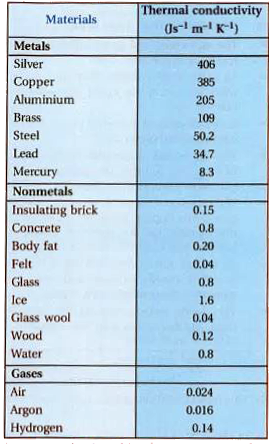How thermal conduction is represented for given temperature difference for any material by rate of heat conduction ? Solution in Gujrati
Consider a metallic bar of length L and uniform cross section A with its two ends maintained at different temperatures.
This can be done, for example, by putting the ends in thermal contact with large reservoirs at temperatures, say TC and TD respectively. Let us assume the ideal condition that the sides of the bar are fully insulated so that no heat is exchanged between the sides and the surroundings.

Here, as as TC>TD, temperatures of different parts increase with time which is shown by dashed line in temperature.
Distance graph :

After sometime, a steady state is reached , the temperature of the bar decreases uniformly with distance from TC to TD,(TC>TD).
The reservoir at C supplies heat at constant rate, which transfers through the bar and is given out at the same rate to the reservoir at D.
Now both dQdt and dTdx remain constant with time. This condition of the rod is called as ..thermal steady state...
It is found experimentally that in this steady state, the rate of flow of heat (or heat current) H is proportional to the temperature difference (TC−TD) and the area of cross section A and is inversely proportional to the length L :
H∝A(TC−TD)L
The constant of proportionality K is called the thermal conductivity of the material.
The greater the value of K for a material, the more rapidly will it conduct heat.
The SI unit of K is S−1m−1K−1 or W m−1K−1.
Thermal conductivity of metals is high and wood, glasswool have vergy less thermal conductivity hence they are good insulators.
Thermal conductivities of some materials :

Topper's Solved these Questions
- THERMAL PROPERTIES OF MATTERBOOK - KUMAR PRAKASHANCHAPTER - THERMAL PROPERTIES OF MATTEREXERCISE - Try Yourself (VSQs)
84 Videos
- THERMAL PROPERTIES OF MATTERBOOK - KUMAR PRAKASHANCHAPTER - THERMAL PROPERTIES OF MATTEREXERCISE - Information : Higher Order Thinking Skills (HOTS)
8 Videos
- SYSTEMS OF PARTICLES AND ROTATIONAL MOTIONBOOK - KUMAR PRAKASHANCHAPTER - SYSTEMS OF PARTICLES AND ROTATIONAL MOTIONEXERCISE - SECTION-F (SECTION-D) QUESTIONS PAPER
1 Videos
- THERMODYANMICS BOOK - KUMAR PRAKASHANCHAPTER - THERMODYANMICS EXERCISE - Question Paper
11 Videos
Similar Questions
''Amount of heat is greater in hot body than cold body''. Check correctness of this statement.
View SolutionWhat is the triple point ?
View SolutionA rope of negligible mass is wound round a hollow cylinder of mass 3 kg and radius 40 cm. What is the angular acceleration of the cylinder if the rope is pulled with a force of 30 N? What is the linear acceleration of the rope? Assume that there is no slipping.
View SolutionWhy is a steam burn more damaging than a burn with boiling water of the same ?
View SolutionThe diagram shows four slabs of different materials with equal thickness, placed side by side. Heat flows from left to right and the steady-state temperatures of the interfaces are given. Rank the materials according to their thermal conductivities, smallest to largest.
View SolutionThe thermal conductivity of a material in CGS system is 0.4. In steady state, the rate of flow of heat 10 cal/sec-cm, then the thermal gradient will be
View SolutionAssertion : Greater is the coefficient of thermal conductivity of a material, smaller is the thermal resistance of a rod of that material. Reason : Thermal resistance is the ratio of temperature difference between the ends of the conductor and rate of flow of heat.
View SolutionThe ratio of the areas of cross-section of two rods of different materials is 1:2, and the ratio of the thermal conductivities of their materials is 4:3. On keeping equal temperature-difference between the ends of these rods, the rate of conduction of heat are equal. Determine the ratio of the lengths of the rods.
View SolutionThe thermal conductivity of a material in CGS system is 0.4. In steady state, the rate of flow of heat 10 cal/sec-cm, then the thermal gradient will be
View SolutionA cylinder of radius R made of material of thermal conductivity K1 is surrounded by a cylindrical shell of inner radius R and outer radius 3R made of a material of thermal conductivity K2. The two ends of the combined system are maintained at two different temperatures. What is the effective thermal conductivity of the system ?
View Solutionकिसी चालक पदार्थ की प्रतिरोधकता में वृद्धि करने के लिए ताप में किस प्रकार परिवर्तन करने पड़ेंगे
View SolutionRate of normal flow of heat in Searle's method for thermal conductivity is
View Solutiond বেধ ও A প্রস্থচ্ছেদের ক্ষেত্রফল বিশিষ্ট একটি পরিবাহীর দুই প্রান্তের তাপমাত্রার পার্থক্য T। পরিবাহীর উপাদানের তাপ পরিবাহিতাঙ্ক k এবং t সময় পরিবাহীর তাপ Q হলে পরিবাহীটির তাপীয় বোধ হল
View SolutionCombined rods made by adding two rods of different thickness but different materials whose thermal conductivities are K and 2K respectively, it will have the same thermal conductivity.
View Solutionवक्तव्य I एक दीवार के दोनों सिरों के तापान्तर में वृद्धि करने पर, उसकी ऊष्मीय चालकता बढ़ जाती है।
वक्तव्य II ऊष्मीय चालकता का मान, दीवार के पदार्थ की प्रकृत्ति पर निर्भर करता है।
View Solution
